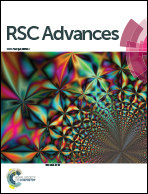Fabrication of cuprous sulfide nanorods supported on copper foam for nonenzymatic amperometric determination of glucose and hydrogen peroxide†
Abstract
Cu2S nanorods supported on three-dimensional copper foam (Cu2S NRs@Cu foam) are in situ prepared by a low-cost and facile method. The structural and morphological characterization of the Cu2S NRs@Cu foam is executed using scanning electron microscopy, transmission electron microscopy, X-ray diffraction and X-ray photoelectron spectroscopy. The high conductivity of copper foam as a current collector can facilitate charge and mass transfer, and the copper foam with an open framework provides large amounts of anchoring sites for the deposition of Cu2S NWs during the synthesis of the Cu2S NRs@Cu foam. Consequently, the Cu2S NRs@Cu foam works as an electrocatalyst for the detection of glucose and H2O2. Electrochemical measurements of the biosensor show an extremely high sensitivity of 11.7508 mA mM−1 cm−2 and a low detection limit of 0.07 μM for the electrocatalytic oxidation of glucose. The nonenzymatic sensor also exhibits a good response toward hydrogen peroxide with a high sensitivity of 1.686 mA mM−1 cm−2. The detection limit is calculated to be 0.2 μM. This method provides an efficient and promising strategy for the construction of practical non-enzymatic glucose and hydrogen peroxide sensors.


 Please wait while we load your content...
Please wait while we load your content...